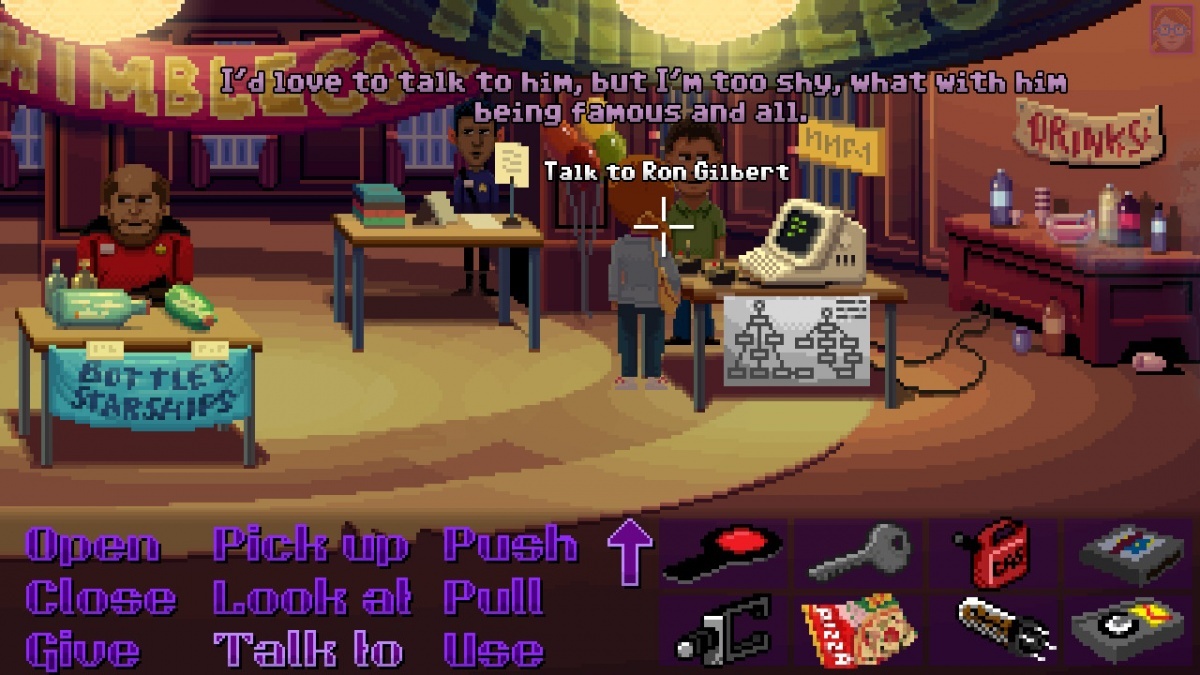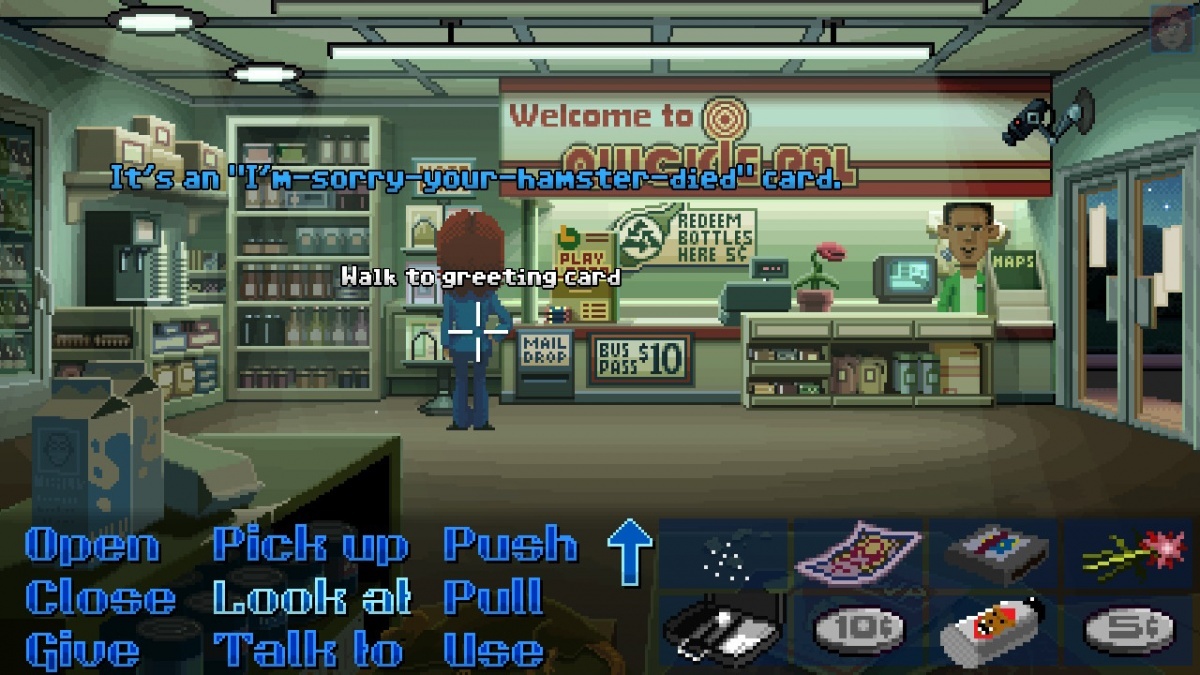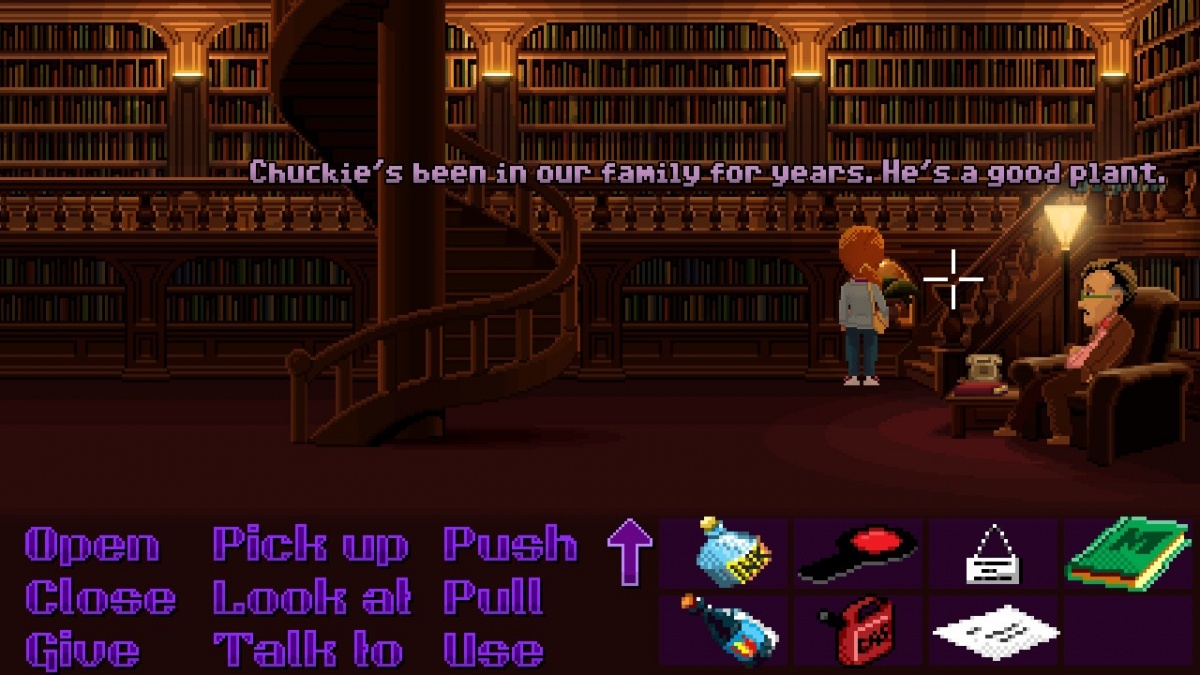Thimbleweed Park (Nintendo Switch) Review
By Rudy Lavaux  21.09.2017
21.09.2017

Point-and-click adventure games have been around for a very long time, succeeding the much earlier genre of text adventures that in and of themselves are pretty much as old as videogaming itself. Cubed3 has already been there in pointing that fact out, but the point this time is that this genre has grown out of favour and popularity in more recent times, save for a bunch of revivals and remasters of such classics like the first two Monkey Islands, Day of the Tentacle and even Grim Fandango, to name but a few. King's Quest is also still around in this modern age but, to be fair, the genre is not as thriving nowadays as it used to be in its heyday, especially in terms of completely new outings. Ron Gilbert and friends, however, did not think so and, after an incredibly successful Kickstarter campaign in 2014, Thimbleweed Park saw release first on PC earlier this year, then more recently on PS4, Switch and iOS, with a release on Android to follow shortly after. How does it shape up on Nintendo Switch?
Following the formula of Maniac Mansion before it, Thimbleweed Park is a point-and-click adventure that allows the player to switch between up to five different playable characters at any time, although not all five are directly selectable at first. It all takes place in 1987 and opens with a murder case in Thimbleweed Park that special federal agents Ray and Reyes have to solve. It is only through their investigation around the murder that the other three will eventually enter the picture and be introduced through flashback sequences until their relevance to the story finally makes them playable, which is an ingenious way of making each character's past known... However, the two federal agents do not get such treatment and their own past and motivations are only hinted at initially and made crystal clear much later on for suspense. Any disclosure of any other plot elements at this point would only ruin the discovery factor that is so important to the enjoyment of such titles but let it be known at least that the plot is well constructed and that, even more importantly, the humour present is still as good as it used to be in old LucasArts games, playing an awful lot on nostalgia for that era, like pop culture references, old technology, films, music, and even actual previous LucasArts releases.
No corners are cut in that area and company names, save for LucasArts' itself, are mentioned in full without any shame, which helps the player build a bigger attachment to the characters and the game world since it will remind of how it used to be in those days with a lot of humour. No more shall be said about it, however, because it has to be sampled to be understood. Immediately striking is the presentation. The style of the visuals lies somewhere in the middle, in terms of detail, between Monkey Island 2: LeChuck's Revenge and Day of the Tentacle. With that said, though, it also gladly strays outside of the limitations of that time, not restricting itself to considerations such as resolution. It may look like a 320x200 game in most situations, but it also uses higher levels of detail where needed, in addition to proper scaling of the characters when they move away from the camera, which shows that it is actually running at a much higher (and more modern) resolution under the guise of retro pixels. The character design, however, using big heads, is very reminiscent of Maniac Mansion. It also uses full voice acting, which is something that wouldn't have been seen from LucasArts classics until Day of the Tentacle and Sam & Max: Hit the Road.

In the end, in terms of visual and audio presentation, it takes cues from all of the games made for the SCUMM engine until the mid-1990s, except for the soundtrack, which is fully pre-recorded and sounds better than anything from that era. It all works well on Switch, save for some light stutters on long horizontal scrolling sections where for some reason the game may drop a few frames here and there, which is thankfully not detrimental to the experience here, but is still weird to see on a title of that level of graphical detail on a system like the Nintendo Switch. This happens just as much in docked mode as in handheld mode, but since this is at time of writing still a pre-release build, there's hope that this gets patched later down the line.
In terms of actual gameplay, however, the interface is practically identical in presentation to the VGA version of The Secret of Monkey Island, as well as other LucasArts titles after it, using the exact same nine verbs used to interact with the environment. This can be both a blessing or a curse as better alternatives have been brought afterwards, such as the icons from Sam & Max: Hit the Road or the cleaner interface of The Curse of Monkey Island, using contextual choices when interacting with an object under the cursor. Thimbleweed Park chooses to rather stay true to its absolute roots, remaining closer to the older games than to the more recent, which can be both a good or bad choice depending on the player's sensibilities.
Having too many ways to interact with the environment means that a lot of the combinations of verbs and objects, or verbs and background elements results in most of them not yielding any other result than "I can't pick that up" or "That won't work." By default, the A button will only move the character to the location pointed if no verb is previously selected, while the B button will perform a default action instead, which can be simply looking at something or picking it up or opening a door, depending on what is being pointed at. In most contexts that default action will be the one that is meant to be used but because the interface only displays what will be done by pressing the A button, the B button action can become a bit unpredictable at times and not yield the expected result, which means the player has to manually select the verb using the control stick instead in docked mode, which can be a pain at times as it slows the pace of the action. The lack of pointer controls on the Switch, when the likes of World of Goo show that they can work wonders when done right using the Joy Con's motion sensing capabilities, is a sad state of affairs.

This, however, is not an issue when playing in handheld mode. With the game coming to other touch screen devices at the same time, it would have indeed been a shame if the Switch's touch screen had not been put to use... but, thankfully, it is! As a matter of fact, holding the Switch with the Joy Con detached and simply playing via the touch screen alone feels absolutely great and gamers on this version won't have any envy of tablet users set to receive it, either on iOS or Android. The main difference and advantage here is that the Switch can also be docked to continue playing on a much bigger screen.
From playing the game for an extended period of time in handheld mode, there's but one small complaint towards the latter: some objects required to complete the story can be small and hard to spot. Direct touch screen pointing means that the player is not hovering a cursor above the objects so their interactive status may not necessarily be made clear right away and those can be easily missed... unless holding a finger down on the screen to move the cursor around in hope of highlighting interactive elements, but then the finger is in the way of the text appearing on screen, so it can't be read. At least, however, the Switch will be the only handheld version that supports both touch screen controls for direct pointing without the need for any other inputs like the iOS and Android versions will, but also for joystick controls to try to highlight objects. Definitely, though, pointer controls in both docked and table-top modes should have been an absolute must, so there's clearly a missed opportunity here.
Some of the other buttons allow for making certain things easier to control, however, like the ZL and ZR triggers allowing to quickly switch between characters without having to click on the dedicated icons on the right side of the screen, while the L and R bumpers allow for quickly highlighting interactive objects in close proximity of where the pointer currently is. This can help locating some well concealed objects that are hard to pinpoint with the joysticks, as mentioned previously, but the nature of the L and R action is sadly hard to predict as it seems to miss some such objects at times. It is helpful for at least one thing: pressing the directional buttons will pass the cursor over to the verbs sections and once a verb is selected, pressing L or R sends the cursor automatically back to its previous position in the environment, which short of having true pointer controls, does make things an extra bit more comfortable and faster.

Things may not be quite as comfortable to play as they could be in docked mode, then, but rest assured it's not a catastrophe either, no more than any other console version anyway... but simply an area in which the Switch, given the proper attention, could have shined brighter than other versions out there, outside of the PC realm. The experience remains nonetheless incredibly enjoyable due in no small part to the cast of playable characters, who all deserve an introduction: Agent Reyes with his Latino accent is a bit forgettable for most of the initial sections sadly, but Agent Ray's constant sarcastic quips make up for it by quite a margin, helped by her voice actor who actually manages to make it hard to decide whether she was acting like she doesn't care about anything, for her character's sake... or whether she truly didn't care for the role, but either way it works in favour of the character's personality. Delores the nerdy, geeky girl who turned into an adventure game programmer is the most loveable of the bunch and always has some deep knowledge of all things technology and pop culture of the '80s, which to the right audience will be delightful. Franklin is a bit of a spineless dude who no one feels sorry for, but is kept interesting by his special abilities, which won't be spoiled here. Last, but certainly not least, Ransome the Insulting Clown is arguably the best of the bunch. Not only is he the most hilarious, but his voice actor does the best job of them all, playing an evil clown always out to hurt other peoples' feelings for his own palpable pleasure. All of the swearing is censored, of course, but the intended vocabulary is suggested enough so that it is clear to educated people what was just said.
All in all, Thimbleweed Park simply revives all of the good things that made the great classics of those days so enjoyable, but brings with it unfortunately the same things that meant some people didn't like them either, such as some convoluted puzzles and a plethora of items to collect, not all of which will necessarily serve a purpose in the greater scheme of things, which can and will be confusing. The hint system where the player calls an in-game phone number for a hotline with tips on how to do certain things or where to find what is needed to accomplish it, makes things more palatable to the modern player, of course, but it's hard not to wish that things were a bit more streamlined like 1990s adventure games such as The Secret of Monkey Island... but veer rather more towards the more harsher conditions of the 1980s strand. Fans of the genre from the 1980s, though, won't and shouldn't care, however, because, within the constraints that it imposes upon itself in trying to replicate that feel, Thimbleweed Park has nothing to envy when compared to those classic titles that it gives reverence to.

Cubed3 Rating
Very Good - Bronze Award

Thimbleweed Park is a massive homage to the LucasArts' games that contributed to make the genre so popular in the mid-1980s to mid-1990s, and made by many of the same people, including Ron Gilbert. For better or for worse, it heavily mixes references and influences to and from the vast back catalogue of titles developed by those guys during those years. If someone didn't like games of that genre back then, even the more player-friendly LucasArts ones, then this one is unlikely to reconcile them with it. On the flip side, those who yearn for more of that type of interactive fun, this will likely be a blast. Minor scrolling stutters aside, Thimbleweed Park plays just as well on Switch as on any other platform, with the advantage this time of being both portable where touch controls rule supreme and playable on the bigger screen like its peers. A missed opportunity lies in the lack of pointer controls to which the Joy Con would have lent themselves pretty well, but it still offers no less than the other versions. Rather more than those, in fact, making this version arguably the best one anyone could want.

![]() 7/10
7/10
![]() 0
(0 Votes)
0
(0 Votes)
 Out now
Out now  Out now
Out now  None
None  Out now
Out now Comments
Comments are currently disabled

 Sign In
Sign In Game Details
Game Details Subscribe to this topic
Subscribe to this topic Features
Features





 Top
Top

